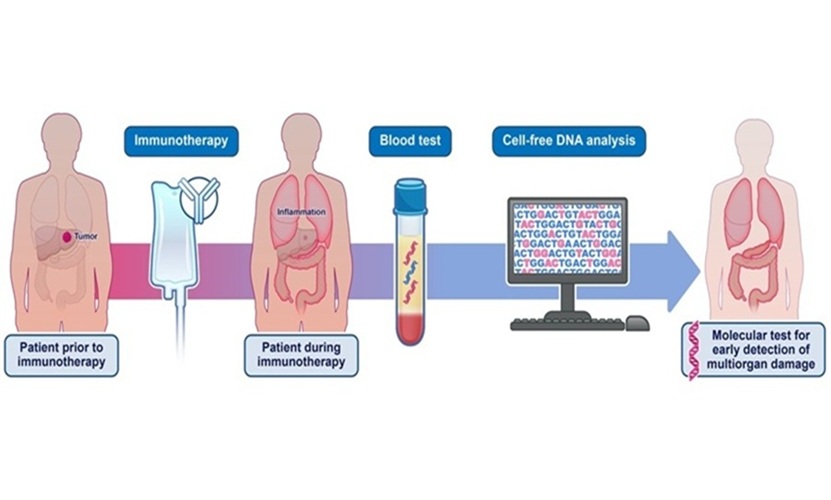Mass Spectrometry Could Enable Early Prediction of Alzheimer’s Disease from Blood Samples
|
By LabMedica International staff writers Posted on 20 May 2022 |

Alzheimer’s disease (AD) is the leading cause of dementia and the most socially significant neurodegenerative disorder among the elderly. AD is characterized by the deposition of beta-amyloid (Aβ) peptides in the form of senile plaques. Although the mechanism of the disease is not yet fully understood, scientists believe that the formation of plaques is one of its causes. Mass spectrometry (MS) is an analytical technique widely used for the analysis of peptides and proteins. It provides information about a biological sample’s composition in the form of a mass spectrum, which reflects the relative abundance of components with different masses, or rather with different mass-to-charge ratios, to be precise. Now, research has confirmed that new MS-based technologies can help better understand the pathogenesis of AD, diagnose it at early stages, predict risks, and create more effective therapeutic approaches.
Scientists at the Skolkovo Institute of Science and Technology (Skoltech, Moscow, Russia) overviewed how MS techniques help to study the diversity of Aβ peptides, which are among the main biomarkers of Alzheimer’s disease. In their previous study using novel mass spectrometry methods, they had found a new potential trigger for the accelerated formation of amyloid plaques in the brain, which are considered to be one of the causes of AD. Aβ peptides are formed by cutting out chunks that are 39 to 42 amino acid residues long from the so-called amyloid precursor protein, which sits in the cell membrane. The resulting Aβ peptide isoforms vary in length and have different biochemical properties. Besides their length, the peptides also differ due to post-translational modifications, or PTMs. These are changes affecting the chemical properties of amino acids that occur after the protein has already been synthesized. It turns out that some PTMs make for Aβ peptides that are especially prone to plaque formation - these are found in high concentrations in the senile plaques of AD patients.
Monitoring the diversity of Aβ peptides may help diagnose the disease more accurately and keep an eye on its progression. MS is the most accurate and precise way to analyze the various types of Aβ peptides. Since amino acids differ in mass, accurate measurements of peptide masses and those of their fragments make it possible to tell one Aβ peptide from another and even recognize PTMs. Unlike the usual PTMs, amino acid isomerization, which is of particular significance for AD, does not change a peptide’s mass and, therefore, its presence is trickier to detect.
In the case of Aβ peptides, spontaneous isomerization of the seventh amino acid in the sequence - the aspartate residue - is of special interest. This modification is often present in the plaques of AD patients and is considered a potential trigger for Aβ accumulation. The results of the latest study by the group of Skoltech scientists demonstrate that mass spectrometric studies of AD plaques can become an effective tool with high sensitivity and specificity, suitable both for validating the results obtained by other methods and for discovering new forms of Aβ peptides. Analyzing how their content varies is of particular importance for elucidating the pathogenesis of AD, predicting the risk of its onset, and developing effective therapy.
“Mass spectrometry allowed us to reach a new level of understanding of the complexity of beta-amyloid peptides, which occur in a great variety of isoforms throughout the body,” explained Alexey Kononikhin, Skoltech Senior Research Scientist. “We showed that their composition changes in Alzheimer’s disease, and detecting some isoforms of peptides - for example, in a patient’s blood sample - can even enable early prediction of AD.”
“Thanks to mass spectrometry, the diversity of various forms of these peptides has been confirmed. This expands our understanding and vision of what is happening: We see not just lots of Aβ peptides, but a whole complex picture. The method works well not only for understanding the pathogenesis of Alzheimer’s but also for better diagnostics, especially at early stages,” Kononikhin added. “We developed a quantitative mass spectrometric method for isomerization detection and studied the dynamic accumulation of peptide forms. We have compared for the first time beta-amyloid peptides from human AD brain tissue and transgenic mice with AD-like symptoms. We saw that the degree of Aβ peptide isomerization in plaques increased with mouse age. And the dynamics of this accumulation is quite interesting. For example, from the seventh month, the content of the isomerized form increases, and starting from 10 months of age, the plaques themselves form rapidly. Thus our findings confirm in part the hypothesis that isomerization may act as a trigger for plaque formation, but further experimental evidence is needed.”
Related Links:
Skoltech
Latest Molecular Diagnostics News
- CLIA Test Identifies Head and Neck Cancer Recurrence from Post-Surgical Lymphatic Fluid
- New 15-Minute Hepatitis C Test Paves Way for Same-Day Treatment
- Ovarian Cancer Assay Outperforms Traditional Tests in Early Detection
- Ultrasensitive Method Detects Low-Frequency Cancer Mutations
- Blood Test Enables Non-Invasive Endometriosis Detection
- New Blood Biomarkers Help Diagnose Pregnancy-Linked Liver Complication
- Simple Urine Test to Revolutionize Bladder Cancer Diagnosis and Treatment
- Blood Test to Enable Earlier and Simpler Detection of Liver Fibrosis
- Genetic Marker to Help Children with T-Cell Leukemia Avoid Unnecessary Chemotherapy
- Four-Gene Blood Test Rules Out Bacterial Lung Infection
- New PCR Test Improves Diagnostic Accuracy of Bacterial Vaginosis and Candida Vaginitis
- New Serum Marker-Editing Strategy to Improve Diagnosis of Neurological Diseases
- World’s First Genetic Type 1 Diabetes Risk Test Enables Early Detection
- Blood Test to Help Low-Risk Gastric Cancer Patients Avoid Unnecessary Surgery
- First-Of-Its-Kind Automated System Speeds Myeloma Diagnosis
- Blood Protein Profiles Predict Mortality Risk for Earlier Medical Intervention
Channels
Clinical Chemistry
view channel
Online Tool Detects Drug Exposure Directly from Patient Samples
Doctors often rely on patient interviews and medical records to determine what medications a person has taken, but this information is frequently incomplete. People may forget drugs they used, take over-the-counter... Read more
Chemical Imaging Probe Could Track and Treat Prostate Cancer
Prostate cancer remains a leading cause of illness and death among men, with many patients eventually developing resistance to standard hormone-blocking therapies. These drugs often lose effectiveness... Read moreHematology
view channel
MRD Tests Could Predict Survival in Leukemia Patients
Acute myeloid leukemia is an aggressive blood cancer that disrupts normal blood cell production and often relapses even after intensive treatment. Clinicians currently lack early, reliable markers to predict... Read more
Platelet Activity Blood Test in Middle Age Could Identify Early Alzheimer’s Risk
Early detection of Alzheimer’s disease remains one of the biggest unmet needs in neurology, particularly because the biological changes underlying the disorder begin decades before memory symptoms appear.... Read more
Microvesicles Measurement Could Detect Vascular Injury in Sickle Cell Disease Patients
Assessing disease severity in sickle cell disease (SCD) remains challenging, especially when trying to predict hemolysis, vascular injury, and risk of complications such as vaso-occlusive crises.... Read more
ADLM’s New Coagulation Testing Guidance to Improve Care for Patients on Blood Thinners
Direct oral anticoagulants (DOACs) are one of the most common types of blood thinners. Patients take them to prevent a host of complications that could arise from blood clotting, including stroke, deep... Read moreImmunology
view channel
Blood Test Could Detect Adverse Immunotherapy Effects
Immune checkpoint inhibitors have transformed cancer treatment, but they can also trigger serious immune-related adverse events that damage healthy organs and may become life-threatening if not detected early.... Read more
Routine Blood Test Can Predict Who Benefits Most from CAR T-Cell Therapy
CAR T-cell therapy has transformed treatment for patients with relapsed or treatment-resistant non-Hodgkin lymphoma, but many patients eventually relapse despite an initial response. Clinicians currently... Read moreMicrobiology
view channel
Blood-Based Diagnostic Method Could Identify Pediatric LRTIs
Lower-respiratory tract infections (LRTIs) are a leading cause of illness and death worldwide, and pneumonia is the leading infectious cause of death in children under five, claiming the lives of over... Read more
Rapid Diagnostic Test Matches Gold Standard for Sepsis Detection
Sepsis kills 11 million people worldwide every year and generates massive healthcare costs. In the USA and Europe alone, sepsis accounts for USD 100 billion in annual hospitalization expenses.... Read moreRapid POC Tuberculosis Test Provides Results Within 15 Minutes
Tuberculosis remains one of the world’s deadliest infectious diseases, and reducing new cases depends on identifying individuals with latent infection before it progresses. Current diagnostic tools often... Read more
Rapid Assay Identifies Bloodstream Infection Pathogens Directly from Patient Samples
Bloodstream infections in sepsis progress quickly and demand rapid, precise diagnosis. Current blood-culture methods often take one to five days to identify the pathogen, leaving clinicians to treat blindly... Read morePathology
view channel
Rapid Low-Cost Tests Can Prevent Child Deaths from Contaminated Medicinal Syrups
Medicinal syrups contaminated with toxic chemicals have caused the deaths of hundreds of children worldwide, exposing a critical gap in how these products are tested before reaching patients.... Read more
Tumor Signals in Saliva and Blood Enable Non-Invasive Monitoring of Head and Neck Cancer
Head and neck cancers are among the most aggressive malignancies worldwide, with nearly 900,000 new cases diagnosed each year. Monitoring these cancers for recurrence or relapse typically relies on tissue... Read more
Common Health Issues Can Influence New Blood Tests for Alzheimer’s Disease
Blood-based tests for Alzheimer’s disease are transforming diagnosis by offering a simpler alternative to spinal taps and brain imaging. However, many people evaluated at memory clinics also live with... Read more
Blood Test Formula Identifies Chronic Liver Disease Patients with Higher Cancer Risk
Chronic liver disease affects millions worldwide and can progress silently to hepatocellular carcinoma (HCC), one of the deadliest cancers globally. While surveillance guidelines exist for patients with... Read moreTechnology
view channel
Machine Learning Models Diagnose ALS Earlier Through Blood Biomarkers
Amyotrophic lateral sclerosis (ALS) is a rapidly progressive neurodegenerative disease that is notoriously difficult to diagnose in its early stages. Early symptoms often overlap with other neurological... Read more
Artificial Intelligence Model Could Accelerate Rare Disease Diagnosis
Identifying which genetic variants actually cause disease remains one of the biggest challenges in genomic medicine. Each person carries tens of thousands of DNA changes, yet only a few meaningfully alter... Read moreIndustry
view channel
BD and Penn Institute Collaborate to Advance Immunotherapy through Flow Cytometry
BD (Becton, Dickinson and Company, Franklin Lakes, NJ, USA) has entered into a strategic collaboration with the Institute for Immunology and Immune Health (I3H, Philadelphia, PA, USA) at the University... Read more



















